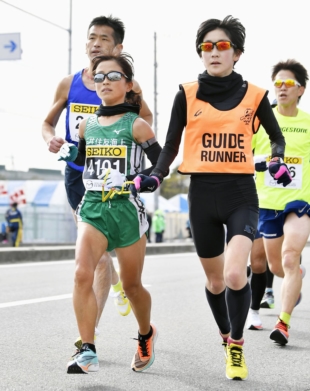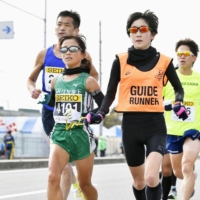Immediately after losing my eyesight, I often found myself moping around the house, listening to Scottish football podcasts and indulging in a little too much red wine. Then I met a blind guy named Yasunori Yamazaki living in Saitama who wanted to practice his English. While talking, Yamazaki told me that he was into bouldering, a sport that involves climbing up an artificial rock wall using hand and foot holds.
In an effort to get out of the house, I accompanied Yamazaki and a couple of other people to a center with an indoor climbing facility. I pictured myself finding a sport for blind people that was just right for me. I also pictured myself reaching the top. Could Paralympic glory be right around the corner?
Yamazaki shot up the wall, feeling out the route with his hands. The other two also passed me by, scrambling up and into the distance. “Sweet heaven, my body’s heavy,” I remember thinking. Holding onto the wall with one hand, I stretched the other out, searching for a hand hold, only to find an overhang. My muscles started trembling.
At this point I realized two things. First, a lot of disabled athletes are actively competing in sports, with many dedicating a large portion of their lives to it. Second, I was never going to be one of them. Before losing my eyesight, I had in fact spent just as much time moping about the house, listening to Scottish football podcasts and overindulging in red wine.
Nothing can better illustrate the sheer number of disabled people throwing themselves into sports than this year’s rescheduled 2020 Tokyo Paralympics. Around 4,400 athletes from 133 countries and territories are scheduled to compete at the Games.
I might require a bag of nachos and a good internet connection to enjoy sports, but the 2020 Tokyo Paralympics offer a perfect opportunity to get a sense of what I am missing. To do so, I reached out to Yamazaki, who tried to get me into the world of climbing, and Nobuko Nagasawa, a blind marathon runner.
Sport climbing, which includes a bouldering discipline, was adopted as an event in this year’s regular Olympics for the first time. However, there’s no similar event planned for the Paralympics.
“It would be cool if it were included in the future,” Yamazaki says, “but it might be a bit late for me, since I’m already 51.”
However, Yamazaki did once take part in a world climbing championship in Sheffield, England.
“When I was a sighted person I loved judo and windsurfing,” he says. “But when I lost my eyesight, I stopped doing sport. I didn’t realize that I could keep doing sport until someone introduced me to bouldering.”
I ask Yamazaki if he feels a difference doing sport now as a disabled person.
“There’s definitely something different,” he says. “For example, blind climbers have a navigator when bouldering. They use clock positions to relay instructions to the climber.”
The navigator gives directions such as, “Left hand to 10 o’clock!”
“It’s different from scaling a wall as an individual,” Yamazaki says. “If your personality doesn’t fit the navigator’s, it won’t work. And, in a certain way, by feeling the wall with your hands, you end up concentrating on the wall more than someone who just looks and sees where the next hold is.”
Yamazaki believes that the Olympic and Paralympic movements could learn something from his experience of mixed competitions.
“In the world of climbing, able-bodied athletes and para-athletes compete at the same championships,” he says. “There are different categories for able-bodied athletes, and others for visually impaired athletes or for amputees and so on. But they compete at the same venue on the same day in front of the same crowd. … In this sense, I think it’s more exciting.”

Nagasawa was born with a visual impairment, and only took up running in her 50s. She now runs full marathons, taking part in events in Japan and abroad.
“When I was young, I didn’t think I could participate in sports,” Nagasawa says. “So I had no interest in sports at all. I only got interested in marathon running 12 years ago. I went to a normal school, but at that time I wasn’t allowed to take part in the sports classes, just cheer from the sidelines. At last I got interested in exercising as a way to lose weight.”
Nagasawa is clearly very enthusiastic about running marathons.
“It’s a great way to get to know other people, especially people outside of your own little world. I have been able to run alongside people from many different countries,” she says. “The first full marathon I ran in under seven hours was the New York marathon, which left a big impression on me. That was about 10 years ago. The support from the crowd was fantastic. I remember people cheering from the sidelines, even police officers. And I heard some Japanese encouraging runners by beating a taiko (drum). With the support of everyone watching, it felt like we were all running on the same team instead of competing against each other.”
Visually impaired athletes run with a guide. The guide runs alongside the athlete, holding one end of a rope with a loop that is called a tether. The visually impaired person holds the other end of the rope and keeps pace.
“Because I had never run before, it was really difficult when I tried it for the first time,” Nagasawa recalls. “But I got used to it before long.”
I ask Nagasawa whether she has been involved in any accidents.
“Oh, yes,” she says. “My guide runner and I have at times become too engrossed in chatting to each other and missed a change in the road conditions, such as a slope or treacherous footing. Without warning, you can easily trip and fall. Even though I’ve fallen, I’ve never broken any bones or anything — just grazed knees or cut my forehead. Usually, though, we just apologize to each other for not paying attention and get back to running.”
The 2020 Tokyo Paralympics opens on Aug. 24. The participating athletes may very well be on another level from Yamazaki and Nagasawa, let alone myself, but they must have all started in a similar fashion — finding physical activity a great way to get out of the house, meet people and stay fit.
Perhaps the Games are a timely reminder that it’s never too late for anyone to find their inner sportsperson.
In a time of both misinformation and too much information, quality journalism is more crucial than ever.
By subscribing, you can help us get the story right.
SUBSCRIBE NOW




